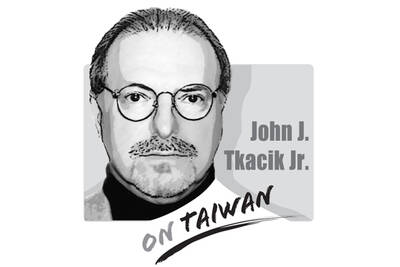The Cabinet last week passed a four-year national development plan which aims to achieve average GDP growth of between 2.8 percent and 3.6 percent from next year to 2028 and increase GDP per capita from US$39,105 to US$42,787 over the same period.
The National Development Council said the government was confident of achieving the goal.
Taiwan could even catch up with Israel — which ranks 14th globally with a GDP per capita of US$55,535 — after surpassing the GDP per capita of Japan and South Korea, it said.
The most critical factors affecting GDP per capita are, assuming that the population remains unchanged, a country’s currency exchange rate and economic growth rate. The persistent rise in Taiwan’s GDP per capita in recent years reflects steady growth in the country’s economy and the local currency better maintaining its value in US dollar terms when compared with other countries.
For Taiwan to continue its growth and maintain its advantage over other regional economies, the country must maintain strong economic fundamentals and avoid uncertainties that might trigger capital flight and negatively affect exchange rates and economic growth.
The nation must also take advantage of technological innovations to increase productivity in traditional and service industries.
It should also achieve net zero carbon emissions to enhance the nation’s competitiveness.
The country’s economic success is built upon the thriving semiconductor industry, which feeds an insatiable global market for the most advanced chips for cars, 5G telecoms, smart devices and artificial intelligence applications.
Most of Taiwan’s export growth is from the information and communications technology (ICT) sector, with little from textiles, machinery, agriculture or other traditional manufacturing and service sectors.
While workers in the ICT industries have received increasing salaries and big year-end bonuses, their peers in other industries continue to face wage stagnation, which has persisted since 2000.
Those working in non-ICT jobs have little reason to celebrate the news that Taiwan’s GDP per capita might surpass that of Japan and South Korea.
This uneven industrial development has resulted in a few tech firms taking center stage in the economy, while the traditional manufacturing and services sectors (excluding financial firms) face continued income inequality due to limited wage growth.
In addition to raising the minimum wage, the government must assist non-tech manufacturing and service sectors in digital transformation and production upgrades, as combined they account for nearly 87 percent of the nation’s employment.
The growth in the nation’s GDP per capita is not too much of a cause for celebration, given that the fruits of the increase have been so unequally distributed among workers. The major beneficiaries have been shareholders.
According to the latest government statistics, the total labor compensation has consistently grown since 2012, but the ratio of labor compensation to GDP dropped from 45.77 percent in 2012 to 43.07 percent in 2021, a new low, while the ratio of corporate profits to GDP increased from 31.82 percent in 2012 to 36.41 percent in 2021, a new high.
Amid changes in the industrial structure, production model and employment dynamics, shareholders’ share of the benefits of Taiwan’s economic growth has gradually increased over the past 10 years or so, while workers’ share has steadily decreased.
Therefore, the government must look beyond the seemingly satisfying GDP statistics and produce policy incentives which encourage corporations to share more of their profits with workers.
This would help lessen the public’s growing sense of relative deprivation.

On May 7, 1971, Henry Kissinger planned his first, ultra-secret mission to China and pondered whether it would be better to meet his Chinese interlocutors “in Pakistan where the Pakistanis would tape the meeting — or in China where the Chinese would do the taping.” After a flicker of thought, he decided to have the Chinese do all the tape recording, translating and transcribing. Fortuitously, historians have several thousand pages of verbatim texts of Dr. Kissinger’s negotiations with his Chinese counterparts. Paradoxically, behind the scenes, Chinese stenographers prepared verbatim English language typescripts faster than they could translate and type them
More than 30 years ago when I immigrated to the US, applied for citizenship and took the 100-question civics test, the one part of the naturalization process that left the deepest impression on me was one question on the N-400 form, which asked: “Have you ever been a member of, involved in or in any way associated with any communist or totalitarian party anywhere in the world?” Answering “yes” could lead to the rejection of your application. Some people might try their luck and lie, but if exposed, the consequences could be much worse — a person could be fined,
Xiaomi Corp founder Lei Jun (雷軍) on May 22 made a high-profile announcement, giving online viewers a sneak peek at the company’s first 3-nanometer mobile processor — the Xring O1 chip — and saying it is a breakthrough in China’s chip design history. Although Xiaomi might be capable of designing chips, it lacks the ability to manufacture them. No matter how beautifully planned the blueprints are, if they cannot be mass-produced, they are nothing more than drawings on paper. The truth is that China’s chipmaking efforts are still heavily reliant on the free world — particularly on Taiwan Semiconductor Manufacturing
Last week, Nvidia chief executive officer Jensen Huang (黃仁勳) unveiled the location of Nvidia’s new Taipei headquarters and announced plans to build the world’s first large-scale artificial intelligence (AI) supercomputer in Taiwan. In Taipei, Huang’s announcement was welcomed as a milestone for Taiwan’s tech industry. However, beneath the excitement lies a significant question: Can Taiwan’s electricity infrastructure, especially its renewable energy supply, keep up with growing demand from AI chipmaking? Despite its leadership in digital hardware, Taiwan lags behind in renewable energy adoption. Moreover, the electricity grid is already experiencing supply shortages. As Taiwan’s role in AI manufacturing expands, it is critical that